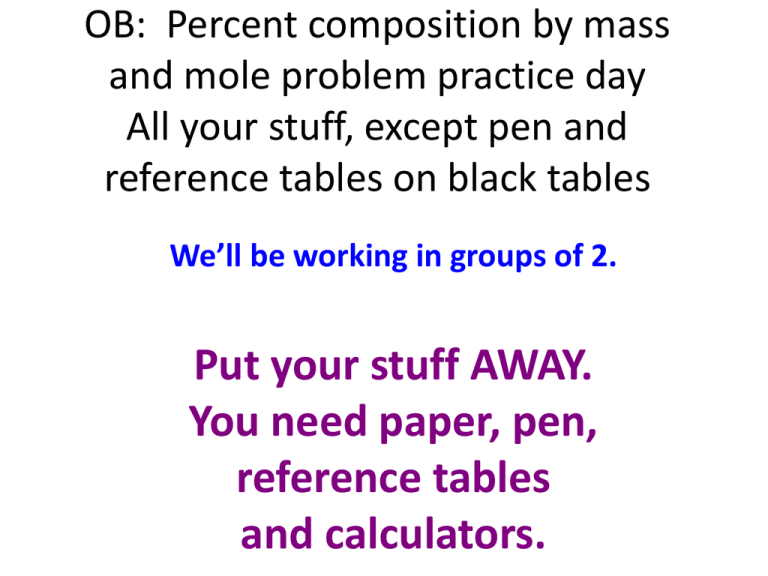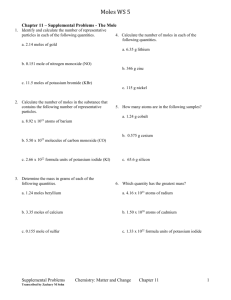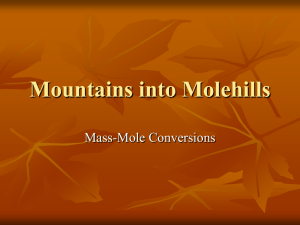Comp + Mole Practice Class
advertisement

OB: Percent composition by mass and mole problem practice day All your stuff, except pen and reference tables on black tables We’ll be working in groups of 2. Put your stuff AWAY. You need paper, pen, reference tables and calculators. Question one: What is the percent composition by mass of aluminum in aluminum hydroxide? Let’s round answers to 3 SF Question one: What is the percent composition by mass of aluminum in aluminum hydroxide Al(OH)3 Al 1 x 27 = 27 Al 27g 78g X 100% = 34.6% O 3 x 16 = 48 O 48g 78g X 100% = 61.5% H H 3g 78g X 100% = 3.85% 3x1=3 78 g/mole 99.95% = 100.% You find a box with a bar of metal that has stamped into it PURE GOLD. The bar weighs 500. grams EXACTLY. How many atoms of gold do you have? You find a box with a bar of metal that has stamped into it PURE GOLD. The bar weighs 500. grams EXACTLY. How many atoms of gold do you have? 500. g Au 1 x 1 mole Au 197 g Au = 2.54 moles Au 2.54 moles Au x 6.02 x 1023 atoms Au = 1 mole Au 1 2.54 x 6.02 x 1023 atoms Au = 15.3 x 1023 = 1.53 x 1024 atoms Au If you have 50.0 grams of sodium hydroxide, how many grams of those are oxygen? If you have 50.0 grams of sodium hydroxide, how many grams of those are oxygen? % Comp by Mass NaOH Na 1x23= 23 O 1x16= 16 H 1x1 = O 16g 40g X 100% = 40% 1 40g/mole 50.0 g x .40 = 20.0 grams oxygen Assume WHAT IS THE STP 346 L neon gas Assume STP 346 L neon gas 346 L Ne 1 15.4 moles Ne 1 x x 1 mole Ne 22.4 L Ne 20 g Ne = 1 mole Ne = 15.4 moles Ne 308 g Ne Some bigger compounds are not in the simple whole number ratio because the molecules are so big and often are made of repeating components. These larger formulas can be “reduced” mathematically into simpler ratios, but this is just math, these simplified formulas usually don’t exist. For example Glucose formula is C6H12O6 which has a 6:12:6 atomic ratio John Dalton said “simple, whole number ratios” for compounds, but this one exists commonly. It’s reduced, 1:2:1 ratio can exist on paper, in our mind, but not for real. These “reduced” to simple ratio formulas are called Empirical formula: CH2O EMPIRICAL FORMULAS They’re math, not chemistry. Let’s figure out some empirical formulas now • • • • • • • • • C6H12O6 (glucose) C8H18 (octane) C24H48 (candle wax) C2H2 (acetylene gas) H2O2 (hydrogen peroxide) C6H6 (cyclohexene) C10H22 (decane) C6H14 (hexane) C5H10O5 (pentose) Empirical formulas are mathematical ratios of atoms to atoms in compounds, written (CONFUSINGLY) as chemical formulas Let’s figure out some empirical formulas now • • • • • • • • • C6H12O6 C8H18 (octane) C24H48 (candle wax) C2H2 (acetylene gas) H2O2 (hydrogen peroxide) C6H6 (cyclohexene) C10H22 (decane) C6H14 (hexane) C5H10O5 (pentose) • • • • • • • • • CH2O C4H9 CH2 CH HO CH C5H11 C3H7 CH2O If you find 11.200 moles of gold and gold is selling for about $40.39/gram, are you rich or just happy, or does it not matter all that much? (hint, how many grams are in that many moles? If you find 11.2 moles of gold and gold is selling for about $40.39/gram, are you rich or just happy, or does it not matter all that much? 11.200 moles Au x 197 g Au = 2206.4 g Au 3SF 1 1 mole Au 2206.4 g Au x 1 _$40.39_ 1 g Au = $89,116 (wow) Due SOON: Mole Lab Bubble Gum Lab TUESDAY: No school











